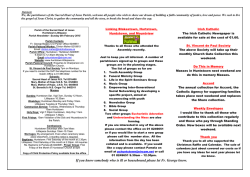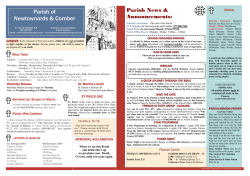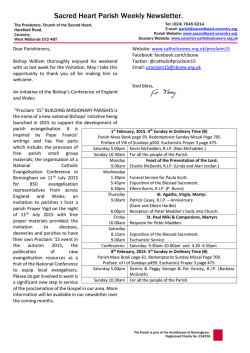
NHDC Local Plan Preferred Options Consultation KWPC response
Kings Walden Parish Council Response to the NHDC Local Plan Preferred Options Consultation, January 2015 Dear Sir Please see below Kings Walden Parish Council’s response to the NHDC Local Plan Preferred Options Consultation. Plan Ref 1. Introduction 2. Vision and Objectives Policy SD1 3, Economy and Town Centres Policy ETC1: Employment Land ETC2 ETC3 ETC4 ETC5: Tourism ETC6 ETC7 ETC8 ETC9 ETC10 ETC11 Comment The parish council recognises the complex balance between housing need and protection of the environment, especially Green Belt. The parish council acknowledges the thorough research that has gone into producing the plan. The parish council acknowledges the provisions of the NPPF and agrees the plans interpretation of the provisions therein. The parish council agrees that all development must be sustainable. This implies the necessary infrastructure must in place at the time of development and believes developers must not be allowed to delay the provision of infrastructure. In many cases this means infrastructure must lead development and arguments regarding viability must not be allowed to skew the need for infrastructure. As most residents of the parish work away in towns in Hertfordshire or Bedfordshire or commute to London, the parish council recognises the need to invest in the towns. However, this must not be allowed to syphon money away from the rural community. There is little employment land in the parish. The parish council looks to the local plan to encourage the rural economy, making use of for example, redundant farm sites as centres of small scale employment. Home working is also an essential part of modern rural life and the delivery of broadband to the parish is an essential part of creating a sustainable rural community. Policy ETC1 should give greater recognition to the requirements of rural employment including mobile and broadband coverage. Policy supported Policy supported Policy supported Tourism is under invested in North Herts. The parish of Kings Walden offers some of the most beautiful countryside and the local plan should make greater benefit of those and not pout the natural beauty at risk. The historic road infrastructure is part of this heritage and development must only be permitted where the existing infrastructure is not damaged. The parish council supports para 3.30 in this respect. Rural bus services need to be supported which may require subsidy to encourage tourists such as walkers. Rural residents use town centre facilities and this policy is supported No comment No comment Policy supported No comment The parish council welcomes the support for new shops in existing communities. The plan should go further by offering business rate relief to shops serving a community of less than 500 houses. Countryside and green belt CGB1 CGB2 CGB3 CGB4 CGB5 T1: Transport T2: Parking HDS1 Housing targets Kings Walden parish lies wholly within the greenbelt and so this part of the plan is critical to the parish. The parish council welcomes the extension of the green belt to include the additional area between Luton, and Hitchin. Policy supported The parish council recognises the need for affordable housing in villages and supports policy the rural exception policy CGB3. The parish council is concerned that developers may seek to take advantage of the apparent loophole for market housing cross subsidizing. Affordable housing does not equate to no profit and any such claim by a developer must be robustly analysed and proven. In particular any cross subsidy must be in the immediate vicinity; it would not be acceptable for market housing in one village to cross subsidise affordable housing in another location. The parish council acknowledges the need of some rural businesses to provide accommodation for rural workers. However, it is known that this policy has historically been abused. The initial use of temporary dwellings is supported. The conversion of unused agricultural buildings should be prioritised over new build. Any housing built under this policy should, if the rural worker use is no longer relevant, be converted to Affordable Housing and reserved for those with a local need and not be allowed to leak onto the open market. While Policy CGB5 is sensible for single buildings any such development must take into account sustainability. If not, this policy could lead to substantial new housing without the concomitant infrastructure. However, all policies need to be pragmatic and take into account the needs of the 21st century including the use of modern materials and the upgrading of old buildings. While in an ideal world, the use of “sustainable transport” would prevail in it inevitable that any rural development will require the use of the motor car to access shops, medical facilities libraries and leisure. Cycling along rural lanes is not a safe alternative and it is unrealistic to plan for even the current level of public transport. Sustainable transport therefore must not be allowed to stifle development and condemn rural locations to dwindle into unsustainability. The use of on call mini-buses should be investigated, where communities can set their own, flexible timetables. Time has proven that lack of parking provision is not effective ion reducing the quantity of private cars. As the average age of a house buyer increases, the number of car per household is likely to exceed the number of bedrooms. In the rural areas any visitors will inevitably use private motor cars. As such any new development must have at least a ratio of 1.5 parking spaces per bedroom. Roads on new estates must be designed to permit a degree of roadside parking. This may require wider roads and/or frequent laybys. To control unsafe parking, all new development should have traffic regulation orders preventing junction parking (using double yellow lines) and should be zoned to ban pavement parking. Housing need projections have little basis in fact. Historical trends are often if not usually distorted by many factors such as the economy, birth rates, East of Luton HDS2 Suggested village boundary Ley Green immigration, migration, all of which are dynamic. As such, any plan must be capable of variation. In practice houses will only be built if they can be sold. To this extent housing numbers set by the LPA are meaningless as the LPA is not a developer. It is unlikely that the market can absorb the numbers proposed. To do so would require more building than has ever been achieved in Hertfordshire and for a sustained 2o year period. In practice the market is unlikely to absorb more than 600 houses per annum peak and so a figure to 2031 of 12,000 will not be achieved (as we are already behind plan by nearly 1000 units). The second issue with these numbers is that the price of housing will be preventive for Hertfordshire first time buyers and so will inevitably draw in migration from London. The parish council believes that the land East of Luton is unsuitable for development and that land to the west is much more sustainable proposition. By allocating land in North Herts, the LPA is avoiding the need of developers to prove their case. Better to risk hostile applications which place the onus on the developer to make the case and where it can be tested at a tribunal. Breachwood Green is designated a Category A village. The definition of a category A village simply states that it should have a school. But to be a sustainable village requires more than just a school. A whole range of facilities (at the very least, a food shop) should be required. The list of villages designated category A is too long and should be further divided into those that have a wide range of facilities and those that do not. Ironically the requirement for villages with minimal facilities is larger development in order to stimulate the infrastructure and make facilities such as shops viable. The assumption in HDS2 is that all parishes should take some development but that it should be in the category A part of the parish. This is to the detriment of the rest of the parish. We note that Kings Walden is not listed but in Chapter 12 it is stated as being a category B village. Why the inconsistency? As the more rural settlements already make use of the central facility (e.g. the school) it does not seem unreasonable to allow some development elsewhere within the parish. The parish council therefore suggest s that Ley Green is given a village boundary. Breachwood Green Village Boundary The proposed village boundary goes some way to resolving the issue that the current development is unusual shape and excluded much of the built environment. However, the new boundary still excludes much of existing housing at the north. The parish council has previously expressed support for a more radical changes to include Darley Road, Windmill Road and Mill Way as per the map below: Your proposal HDS3 Affordable Housing HDS4 Density HDS5 Relatives’ and dependants’ accommodation. HDS6 Gypsies and travellers Our proposal The general provisions of policy HDS3 are welcomed. However, it is not unreasonable that development so less than 10 dwellings should make some contribution to affordable housing albeit by money collected via a S106 agreement. It should be a firm policy that the affordable housing should be co-located with and integrated within the market housing and that to the casual observer there should be no discernible difference between the two, The use of commuted sums to fund housing on a remote location is not acceptable. The policy omits any mention of height. The way to increase density without increased land take is to make more use of basements and loft spaces. All new houses should be designed with at least 2.5 storeys. This should not just be restricted to towns. Historically many village houses had attic rooms. Basements make better use of land without increasing the visual impact. Developments should achieve a balance of maximising height while not detracting from the visual street scene. The parish council supports this policy but questions the need for point 4. Rural areas should be treated the same as urban areas. The policy is too specific. The site at Pulmer water is a single (albeit extended) family site and is not available to gypsies or travellers from other families. The parish council notes that point 2 species that residents must have access to local shops but notes that this restriction is not being applied to other types of development: many villages do not have access to a shop (e.g. Breachwood Green.). The policy should also state that the same planning considerations will apply to gypsies and travellers as to the general public. D1 Design and Sustainability D2 House Extensions and Replacement dwellings D3 Protecting living conditions D4 Air quality HC1 Healthy communities HC2 Green space NE1 Landscape and Environmental Protection NE2 Green Infrastructure NE3 Biodiversity NE4 Renewable energy NE5 sustainable water supply NE6 Flood risk Chapter 12 Kings Paragraph 7.13 states that “cars should not be a dominant feature at new developments”. History has shown that placing car parking at a distance or to the rear of a property does not work. All development, especially in rural areas where a car is a necessity must have off road parking and roadside parking restrictions. Use of garages for cars cannot be enforced and conversion of garages cannot be prevented. Therefore garages should not count towards parking provision. New housing developments need to be integrated into existing communities. As such, cul-de-sacs estates with a single access point and gated communities should be discouraged. Paragraph 7.17 is unrealistic. The market will decide on the need for expanded houses and where the curtilage allows larger extensions I rural areas should be permitted. Many rural dwellings are small relative to the plot; this is poor use of land. Paragraph four of the policy regarding isolated rural location is unnecessary and unnecessarily restrictive. Pitched roofs may have a pleasing visual appearance but can be poor use of space. Flat roofs, disguised behind dummy pitched roofs should be encouraged. The parish council supports the restriction on building up to the boundary but this should also apply to single storey extensions. Replacement of dwellings in rural areas with larger properties should not be restricted. Such development can be crucial to the sustainability of rural communities. No Comment Policy is supported Policy is supported All developments where children are likely to live should include safe, well designed play areas. In parished areas, a commuted sum should be paid to the parish council for the ongoing maintenance and upkeep of play areas with a legal obligation to maintain the equipment in perpetuity. Policy is supported Otherwise, policy supported. Policy is supported Greater emphasis should be placed on point 1. Renewable energy proposals that have a detrimental impact on the country side (such as wind and solar farms) should be resisted, despite the energy benefits. Biomass may be a more suitable use of land to fulfil the renewable energy remit. New developments should incorporate solar power cells into the roof as part of the design. This policy should be strengthened. The use of grey water (not rainwater) for flush toilets should be mandatory. Rainwater recycling is a useful supplement but the amount of rain is insufficient to cover the costs of such systems. In rural areas, efficient waste disposal can be made using modern technology without the need for mains drainage, which requires large amounts of water to transport waste over long distances. Renewable energy plants utilising waste should be encouraged. Policy is supported The parish council notes the site would deliver 2 affordable units. The Walden housing needs survey determined a need for 12 units and so by implication 10 units would need to be delivered under the rural exceptions policy. NE7 Water quality and environment NE8 Water Framework NE9 Contaminated land Policy is supported HE1 Heritage ID1 Developer contributions ID2 Master plans Part 1 Kings Walden Part 2 Cockernhoe Part 3 West of A1M Policy is supported Bringing contaminated land back into use is important. Consideration should be given to reducing S106 obligations where the viability of a scheme is threatened. The parish council recognises the need to manage the historical estate. However, this must be balanced with the need to live in the 21st century and sympathetic development and the use of modern material must be permitted. Viability calculations should be reassessed at the completion of a scheme as well as at planning. Where the sale price of units exceeds the planned sale price, any reduction in planning obligations should be reversed. No comment The parish council supports the proposal for KW1. The parish council objects to the proposal to develop land at Cockernhoe and to incorporate the villages of Cockernhoe, Tea Green and Mangrove Green into an eastern extension of Luton. The parish council believes that Luton’s needs can be met by development west of Luton. Any development to the east would never provide the infrastructure necessary. Traffic from any new development would try to find ways out through the narrow lanes of rural North Herts and would have significant impact on the parish of Kings Walden. Should it prove necessary to develop east of Luton, for Luton’s needs, Luton Borough should pay for nomination rights to any affordable housing. Questions have been raised as to the land value and the LPA has indicated that CIL could be set at a lower level for this area due to proximately to Luton. This is a fallacy; the uplift in land value (planning gain) from farmland to housing would be ample to provide S106 or CIL obligations. Should it prove necessary to develop west of Stevenage, for Stevenage’s needs, Stevenage Borough should pay for nomination rights to any affordable housing. Questions have been raised as to the land value and the LPA has indicated that CIL could be set at a lower level for this area due to proximately to Stevenage. This is a fallacy; the uplift in land value (planning gain) from farmland to housing would be ample to provide S106 or CIL obligations.
© Copyright 2026







